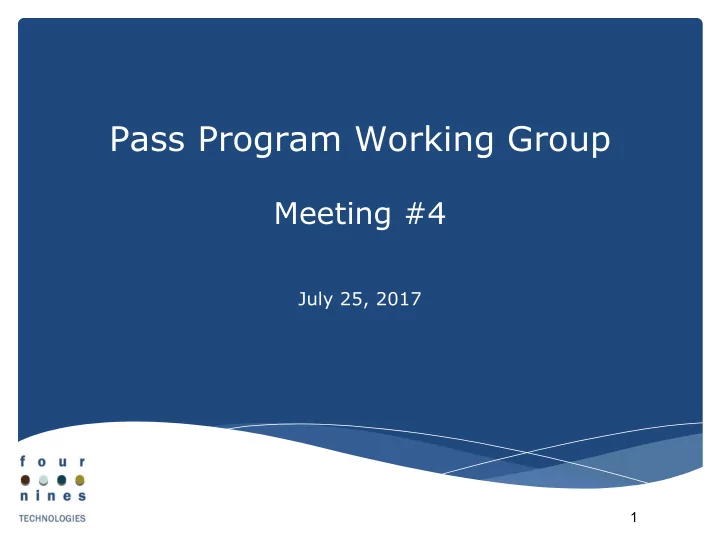

Pass Program Working Group Meeting #4 July 25, 2017 1
Key Questions to Guide Development ❏ Who is RTD trying to serve (e.g., K-12 students, employees, low-income riders, others)? ❏ What is the program trying to accomplish (e.g., affordability, increase transit mode share, mobility)? ❏ How should the program be priced (e.g., opt-in, all-in)? ❏ Should certain market segment(s) receive a discount? How do you prioritize who gets a discount? ❏ How will the program be funded? Who pays? How will the program be funded into perpetuity? ❏ How will the program be administered? Who will be responsible for which components of administration (e.g., eligibility, verification, distribution)? ❏ How does technology enable or constrain the feasibility of a program? What investments (e.g., in time and financial resources) would programs that are beyond RTD’s current technological capabilities require? ❏ Is there another, simpler way to achieve a similar outcome? 2
Pass Program Elements 3
Market Access RTD Service Area 4
Market Access Cont. 5
Pricing Pay As You Go Pass Products Lowers cost per boarding since no Incentivizes passholders to travel more Pros Pros discounts associated with pass products with pass; reward loyalty & freq riders Disincentivizes riders from traveling Affordability of monthly & annual passes Cons Cons more if no convenient way to pay can pose a financial barrier for riders Variation: pass accumulators - a hybrid of pay as Variation: passes sold to organizations at full face you go and pass products by capping fares paid value or discounted amount Rider Category Discounts Time of Day Offer discounted fares to reflect ability to Incentivizes travel with discounts during Pros Pros pay and comply with FTA half fares off-peak when capacity is available Requires enforcement of eligibility, Does not address mobility needs for Cons Cons increasing administration costs those who need to travel during peak Variation: traditionally based on age (e.g., senior, Variation: limit mandatory half fares for seniors & K-12) or disability, but increasing interest in income persons with disabilities to off-peak
Pricing Cont. Bulk Sales Subsidy / Fare Buy Down Incentivizes ridership by lowering fares Depending on distribution method, bulk Pros through sponsorship or fee assessed to Pros sales can result in admin cost savings riders & non-riders to cross-subsidize Limited purchasing power of smaller Important to ensure sufficient funding to Cons Cons organizations to purchase fares in bulk prevent impact on operating budget impacts access to discounts Variation: sponsor purchases fares at full price and Variation: discounts based on organization type provides discount (or free) to rider (e.g., EcoPass, (e.g., Nonprofit Program), not based on quantity Neighborhood EcoPass, NonProfit Program) Introductory Promotions Universal Free Fares Pros Incentivizes ridership Target new riders; incentivizes ridership Pros by lowering fares Important to ensure sufficient funding; impact of free fares on perceived Limited success creating new long-term Cons value/ownership; increased ridership Cons riders; incentive needs to be long during peak when capacity is limited enough to create habit Variation: limit free fares to select populations Variations: promotions to introduce new fare media; (e.g., low income youth) to achieve specific goals promotions for new residents, employees, etc.
Option Development ❏ What markets would have special pass programs? ❏ Who should RTD be trying to serve (e.g., K-12 students, employees, low-income riders, others)? ❏ What would program be trying to accomplish (e.g., affordability, increase transit mode share, mobility)? ❏ What pricing models would be used for the different pass programs? ❏ Should certain markets receive a discount? How do you prioritize who gets a discount? ❏ How would distribution be handled for the different pass programs? ❏ Are there obstacles to this option? 8
Recommend
More recommend